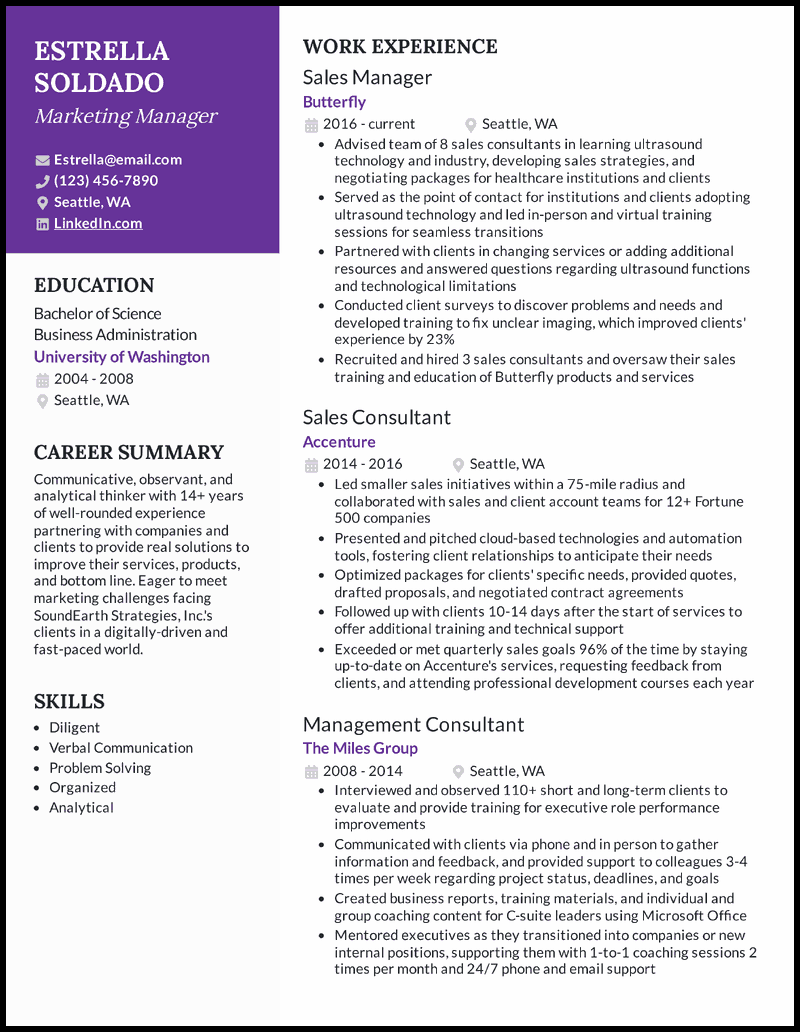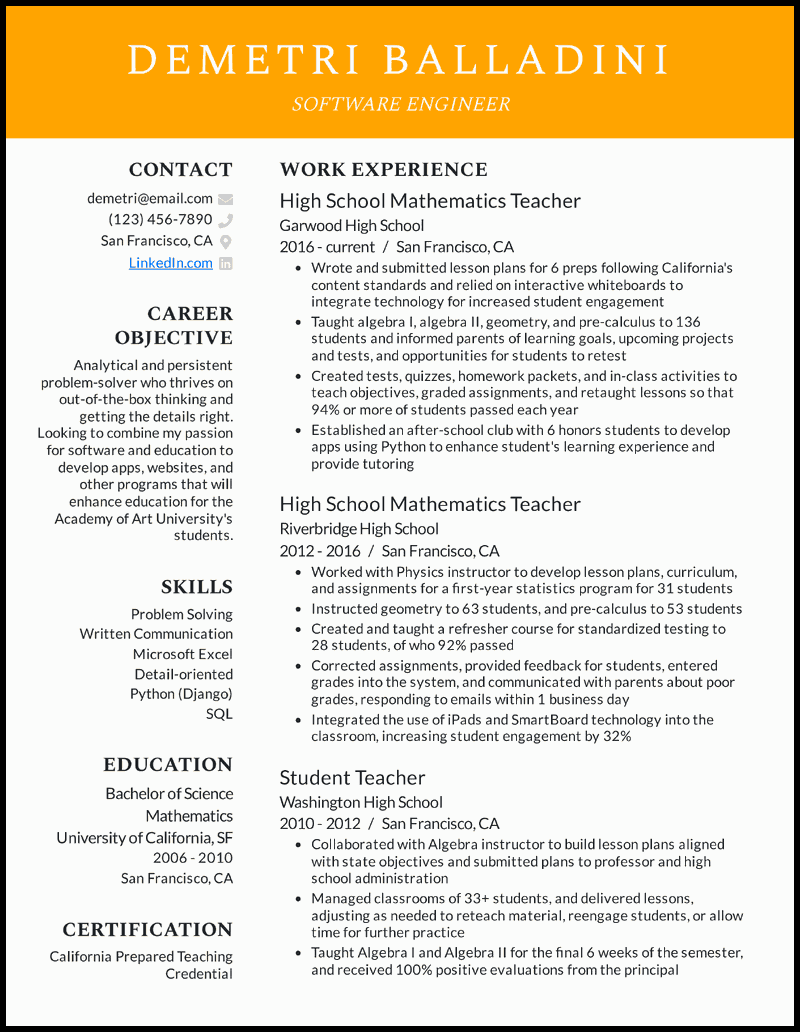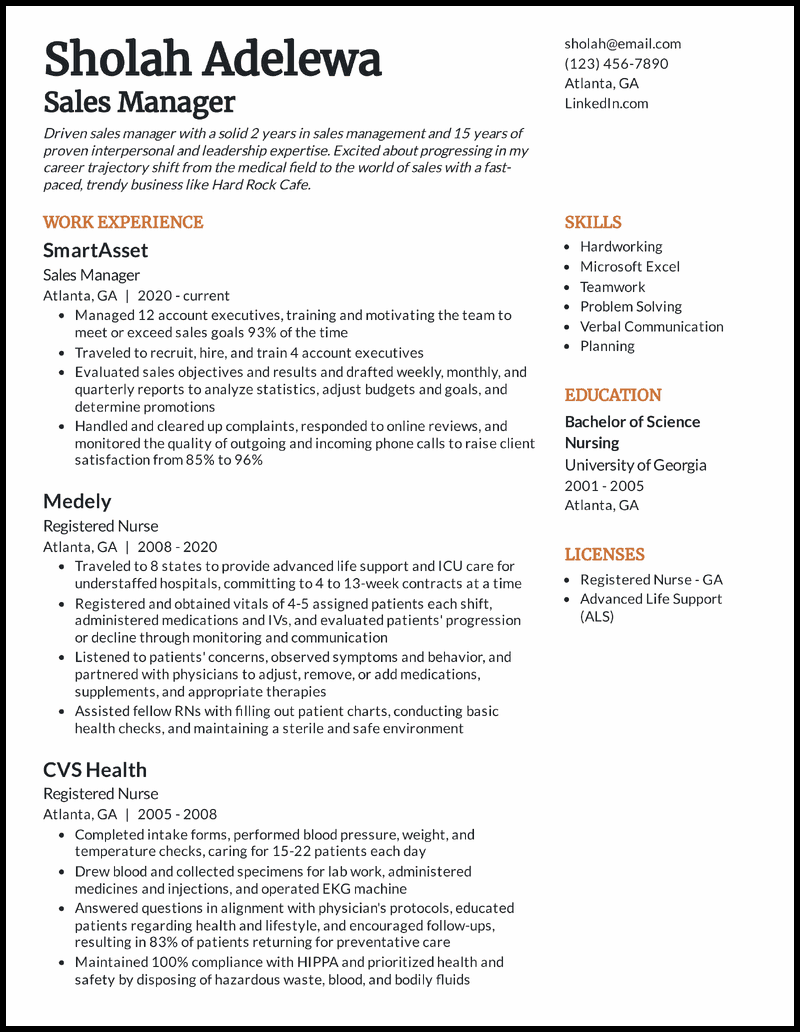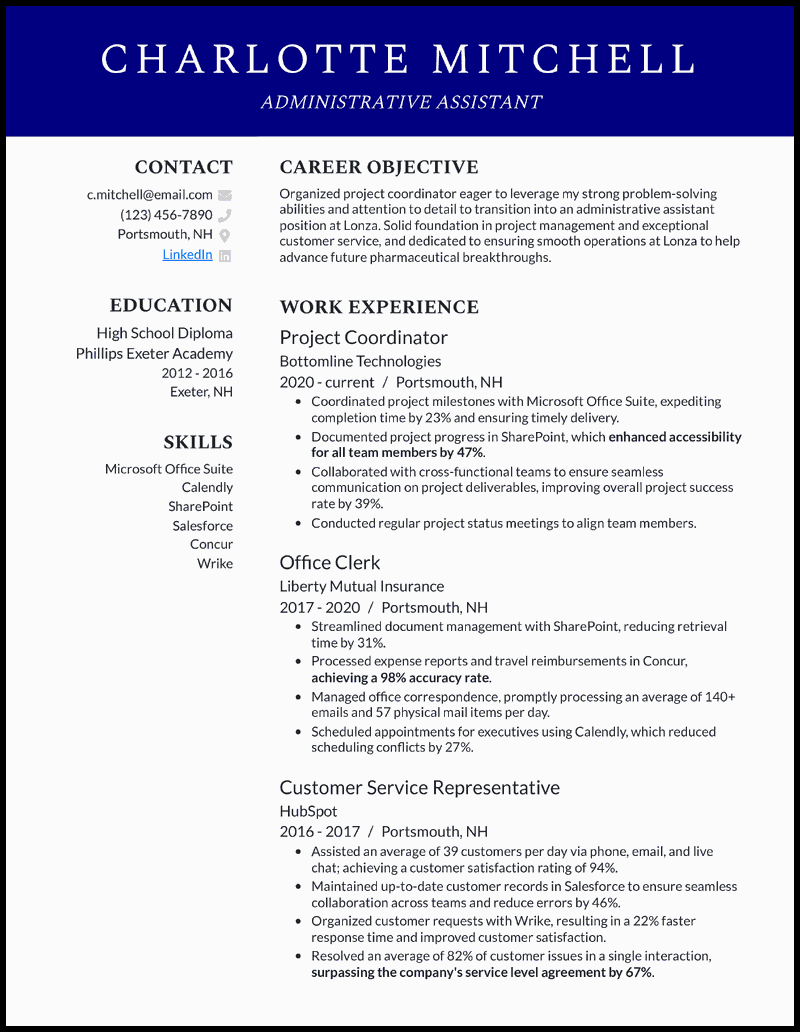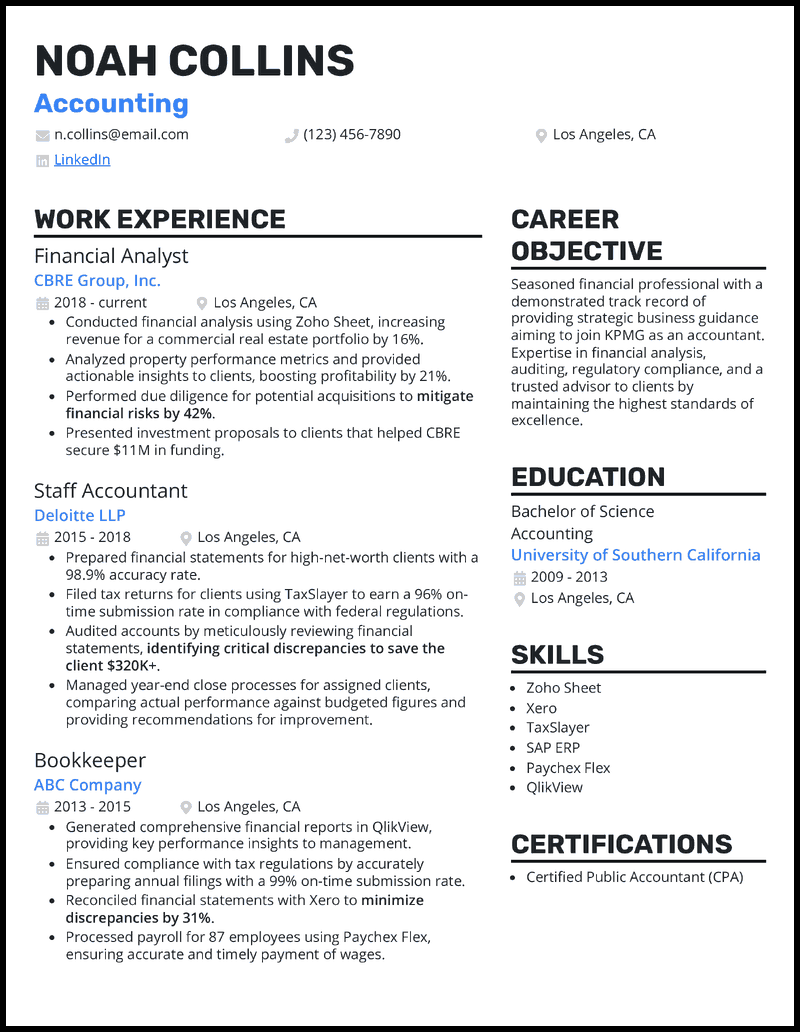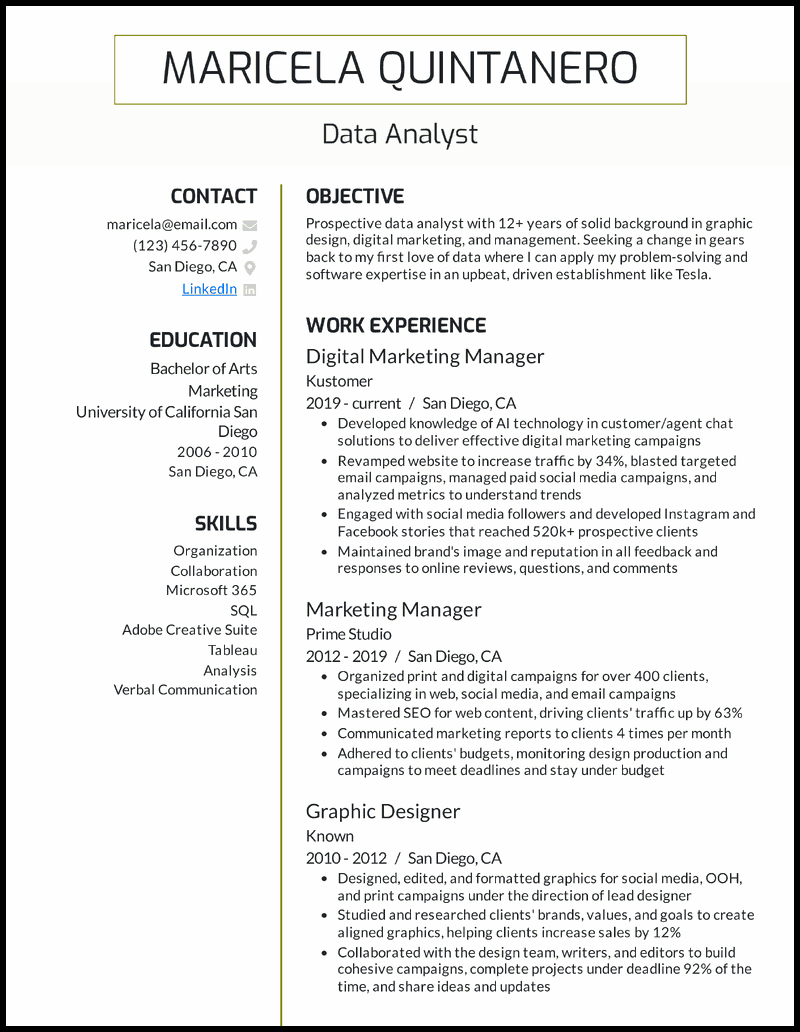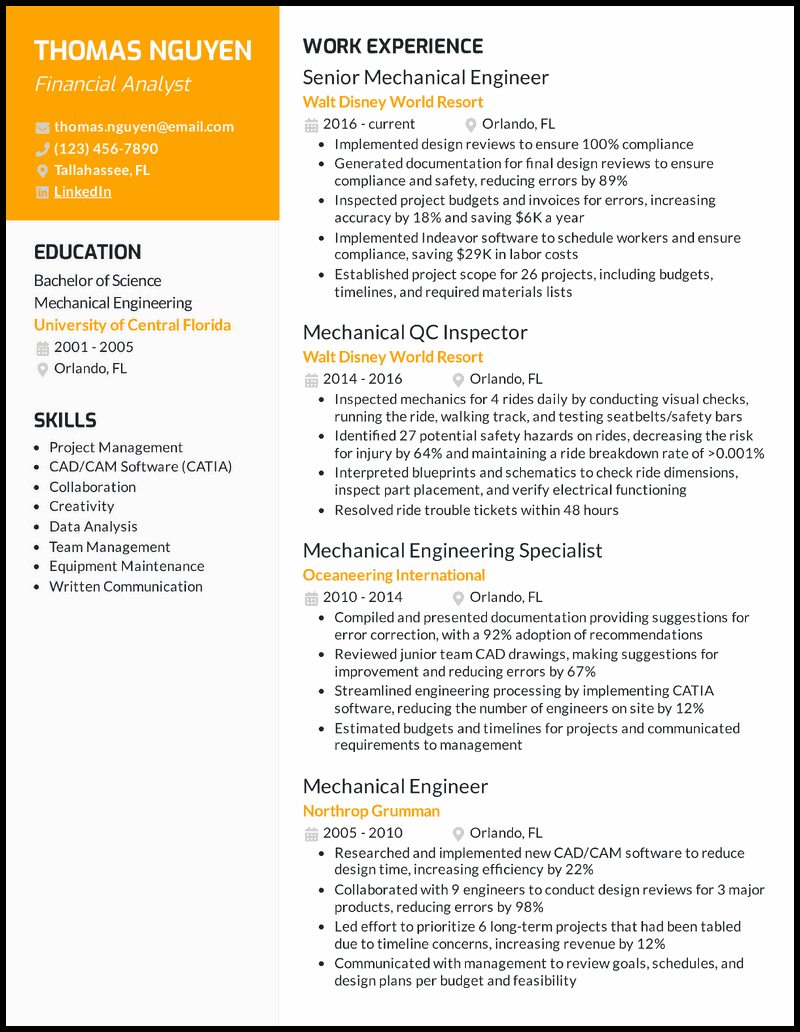Making a career change often feels daunting, but your career change resume doesn’t have to hold you back. A strong application can help you step forward with clarity and confidence, whether shifting industries or returning to the workforce.
Here, you’ll learn how to:
- ↪Make a resume that positions you as the change driver the company needs
- ↪ Tailor your experience to fit new roles
- ↪ Highlight transferable skills that hiring managers value
- ↪ Tap the power of making a persuasive cover letter to explain your “why”
Before you’re set to apply, use a reliable resume checker to spot formatting issues and keyword gaps so your application stands out—both to hiring managers and applicant tracking systems (ATS).
Why this resume works
- A resume summary is one of the most valuable things you should include on your career change resume. Career summaries highlight any specializations or unique skills you’ve developed throughout your career.
Why this resume works
- The work experience bullet points occupy the largest share of your CV—no more than four bullets for each role. As for your contact info, education, skills, hobbies, and certifications, a side column will do the trick. The cherry on top is restricting the entire resume to one page.
Why this resume works
- Mention the relevant transferable skills you bring to this entry-level role, a requirement Elijah executes well in his teacher to human resources resume. Better yet, let your bullet points show how you used these proficiencies in previous teaching roles.
Why this resume works
- Many skills indirectly transfer from one job to another. Consider your collaboration skills: your ability to work well with fellow teachers will help you work on team projects at your next job. Of course, if you have any skills, projects, or experience in your new field, include them, and explain how you’ve mastered them in your career change cover letter.
View more teacher career change resumes >
Why this resume works
- Mentioning your adherence to HIPPA guidelines can demonstrate to hiring managers that you will stick to the rules. On the flip side, explaining how you used active listening to assist patients will show your compassion and customer service skills.
View more RN career change resumes >
Why this resume works
- Even a career change to a closely related role can benefit from a resume with a career objective. If you’re shifting from a project coordinator to an administrative assistant, you can leverage many of your existing organizational skills to succeed in the new position.
Why this resume works
- Landing a job during a career transition can feel like threading a needle in a windstorm. A career change to marketing resume that spotlights relevant transferable skills can help calm the chaos.
Why this resume works
- To boost your odds, ensure your career change to data science resume illustrates any relevant education or training. A degree in computer engineering says you have amassed the foundational knowledge to thrive in a data science role (like math, programming, and analytical thinking).
Why this resume works
- Use your skills to drive your abilities home within your work experience bullet points. Maybe every job you’ve ever worked has required customer service skills, or perhaps you’ve needed computer and software proficiency.
Why this resume works
- Not every business professional can make this move—you need to quickly establish that you have all the necessary qualifications to perform the job. If you’re applying to be an accountant but it wasn’t your most recent role, be sure to add a certifications section highlighting that you are a Certified Public Accountant (CPA).
Why this resume works
- Ensure your software engineer career change resume applies to standard resume formatting rules before you submit your job application. Start by keeping your resume to a single page. It’s also best to use reverse-chronological formatting on your resume to keep your most relevant job history at the top.
Why this resume works
- Few things will carry more weight in your marketing manager career change resume than the use of metrics. No matter how different your new career may be, an employer will be more likely to invest in you when they see measurable data from your experience.
Why this resume works
- Consider asking a friend, relative, or even a career advisor from your alma mater to scan your resume for errors and discrepancies. Nothing tells a recruiter you’re not the right person for the job like saying you’re great at “time management.”
Related resume guides
How to write a Career Change Resume

A career change resume must bridge your past experience with your future goals and align with the industry you’re eager to join. It should highlight transferable skills, quantify achievements, and tell a clear, convincing story of why you’re pivoting — and what makes you a valuable asset in the new field.
Find here:
- Must-include sections for a career change resume
- How to write a compelling summary
- How to present your skills and achievements from your past
- Formatting tips for ATS and hiring managers
- Answers to all questions to make a smooth transition

What should you include in a career change resume?
A successful career change resume should include:
- Summary statement detailing your suitability for the new role
- Transferable skills with real-world examples that add context
- Relevant work experience with results that demonstrate your capabilities
- Education & certifications, especially the ones showcasing recent upskilling
- Keywords from the job ad, responsibilities, and skills

What is a career change resume summary?
A career change summary etablished your grounds for switching fields and emphasizes the transferable skills, experiences, and value you bring. It’s your elevator pitch, often condensed into two to three lines. Unlike a traditional resume, it puts less emphasis on chronology and focuses more on your fitness for the new job’s requirements.
Example
Senior software engineer with over a decade’s experience building scalable systems in the tech industry. Skilled in Python, SQL, and machine learning; led the optimization of a cloud platform that reduced latency by 44%. Transitioning to data science to apply analytical strengths in uncovering actionable insights from complex datasets.

Why are keywords important on a career change resume?
Modern recruiters and AI screeners look for job-specific keywords as the first indicator of your resume aligning with the role’s expectations. So, pull these phrases from job descriptions and integrate them naturally into your resume — especially in:
- Job titles
- Achievements
- Summary
- Skills section
If your resume doesn’t include relevant skills, tools, and action verbs, it will probably be filtered out before a human sees it. Therefore, tailor your resume to match the job post.
Example
If the job mentions “stakeholder communication” and “project tracking,” include examples of you presenting to executives and tracking KPIs.

Craft a summary statement
In two to three lines, talk about yourself, your reasons for changing careers, your unique skills, and why you’re the best fit for the job. You will use everything in your professional kit to prove to recruiters that you deserve their attention.
Typically, using active verbs and combining them with relevant keywords will elevate your application, and you’ll probably have a great day with the hiring team during an interview.

What is a career change resume summary?
It’s a brief statement explaining to human resource managers why you’re making a career switch and how your transferrable skills would be valuable in the new role. It sums up your qualifications in a compelling way that would make recruiters want to hear more about you and shortlist you for an interview.
Example of a career change resume summary
Innovative and results-driven professional with over a decade of experience in software engineering, now channeling a passion for data-driven decision-making into a dynamic career in data science at IBM. I thrive on uncovering insights from complex datasets, turning them into actionable strategies that drive business success.

How to showcase your transferrable skills
On a conventional resume, listing your skills is straightforward because you’re applying for a job directly related to your career path. However, for a career change resume, the hiring manager may not immediately connect the dots between your former work and the new industry you want to join. Therefore, your best strategy is to use transferrable skills and showcase how you can use them to make an impact in the new job.
These skills should be the soft and technical abilities you’ve learned from previous roles. Don’t just list them; go further and demonstrate how you’ve used them to achieve results. If used well, even without direct experience, recruiters would understand why you would be a perfect addition to their team.
Examples of transferrable skills for a career change resume
- Problem-solving
- Collaboration
- Writing
- Planning
- Data analysis
- Coding
- Excel

Highlight the most relevant work experience
This section will have a say on whether you’re successful or not. So, ensure you only include the most relevant experiences from your work history. Go for the roles that show as a natural fit for the new role and emphasize your adaptability to changing work environments.
When you talk about your work experience, avoid concentrating on your responsibilities. Instead, demonstrate your measurable accomplishments, the skills used, and how you would make an even bigger impact if you get the new job.
Using numbers to show monetary gains, time saved, and efficiency can effectively elevate your pitch and have hiring managers pay more attention. Also, use action verbs to start your job descriptions and showcase a result-oriented mentality in your pitch.
Finally, it’s necessary to explain any gaps in your career. You may have done a personal project, taken a health-related break, or returned to school. Let a potential employer know about whatever you did during that period.
How to add related work experience for a sales manager switching to a marketing manager:
Work experience
Sales Manager
Butterfly
2021 – Current Seattle, WA
– Coached a team of 8 sales consultants in learning ultrasound technology and industry, developing sales strategies, and negotiating packages for healthcare institutions and clients
– Conducted client surveys to discover problems and needs and developed training to fix unclear imaging, which improved clients’ experience by 23%
– Recruited and hired 3 sales consultants, enhancing their expertise and driving a 21% increase in sales of butterfly products

How do you write work experience for a career change?
Create bullet points that focus on relevant and impactful accomplishments that give employers value for their resources, not just a list of responsibilities. Frame your past roles as signposts for adaptability, impact, and value-adds transferable to your new career path.
Examples of bullet points for a resume switching from sales to marketing
Sales Manager, Butterfly (2021–Present) — Seattle, WA
- Recruited and trained 3 sales consultants, leveraging HubSpot CRM Navigator to streamline onboarding and drive a 21% YoY sales growth
- Developed customer success initiatives using Salesforce Service Cloud and Qualtrics CX surveys, resulting in a 23% boost in satisfaction scores
- Collaborated with product and marketing teams via Slack to design a customer feedback loop, directly influencing messaging strategies and improving feature adoption rates

Include education and certifications
Formal education shows your professional background and tells employers that you’ve been through training to learn the best practices for a particular industry. If you lack direct work experience, including your GPA and coursework, it may help seal the gap. When listing your education, use the reverse chronological order, whereby you start with the highest/most recent level of education.
Certifications are also essential because they tell recruiters that you are dedicated to the profession and eager to keep up with the latest trends. Such certificates also show that you comply with strict professional requirements and standards.
Education
Bachelor of Science
Business Administration
University of Washington
2014 – 2016
Seattle, WA
Certification
Google Developer Program, Google
May 2024
Coursework: Overview Google Cloud, Setting up VS Code, Responsive design with Material Design, Firebase Authentication, REST API concepts, and Mobile app demo on emulator.
What certifications help with career switches?
Certifications signal credibility and, in this case, prioritize the ones that fill knowledge gaps in your new path.
Examples of certification for common pivots:
- Marketing: Google Ads, HubSpot, Meta Blueprint
- Data: Google Data Analytics, SQL, Tableau
- IT: CompTIA, AWS Certified Cloud Practitioner
- UX: UX Design by Google, Nielsen Norman courses

How do you format a career change resume?
Use a hybrid resume format — a blend of functional and chronological orders. Start with a summary, follow it with skills, and highlight your achievements. Detail your work history, prioritizing the most recent and relevant roles, and close with education and certifications. Be careful not to prioritize job titles over skills.

What jobs are best for career changers?
The best jobs for career changers allow you to build on existing skills. When strategizing for the change, look for roles with skill overlap rather than full reinvention. As long as you can prove valuable to your potential employer, your switch will be seamless.
Examples include:
- Project manager to operations lead
- Teacher to instructional designer or HR
- Sales rep to marketing associate
- Developer to data analyst

What should a cover letter for a career change include?
Start with your motivation for the switch, add context to your relevant transferable skills, and share specific examples of success in prior roles. Address the employer’s needs directly and position yourself as the asset they need. Acknowledge your pivot — but be firm on your readiness and value-add for the new role.

How do you explain a resume gap after switching careers?
Address gaps briefly but confidently—you can’t wish them away. Whether you took time to study, care for family, or start a business, underscore the new skills, achievements, and certifications earned. You can mention this in your summary or as a short entry at the top of your experience section.

What common mistakes do career changers make?
Don’t commit any of these mistakes for a successful career change:
- Submitting a generic resume for every role
- Disregarding transferable skills
- Focusing more on job duties and not outcomes
- Elevating irrelevant roles to the top
- Skipping the career change reason in your summary

Key takeaways
- Be clear about your career change motivation from the onset
- Use a summary statement to set the tempo for the rest of your application
- Give transferrable skills the importance they deserve
- Address career gaps confidently
- Pick and present your best achievements from the most recent and relevant roles
- Customize each resume for the specific role and industry
Career Change Resume FAQs

A strong career change resume starts with an overview of your professional background, top achievements, and the reason for the switch. Ensure to spotlight your transferable skills, measurable results from past relevant roles, supported by appropriate education and certifications that show you’re fit for the new path.
Start with a tailored career snapshot
Put transferable skills at the front and pair them with quantifiable wins
Establish authority with certifications and relevant coursework
A career change resume should clearly present your past roles, aligning them with your new target. Use a ****combination or hybrid resume format to put skills and achievements front and center. Put each of these sections under a defined header: summary, skills, experience, and education, and ensure each is easy to skim and parse by recruiters and ATS.
Use a combination format (skills + achievements)
Keep sections clearly labeled and skimmable
Focus on relevant, quantifiable accomplishments
Yes. Update your resume to respond to the demands of the new role. Retouch your skills, work history, and summary to reflect what the target industry values most.
Tailor for relevance, not chronology
Prioritize transferable experiences
Align language with the new industry
Write a summary statement, focus on transferrable skills, add the most relevant work experience and projects, and highlight your relevant education and certification. Also, ensure that you update your resume to align with the new industry. Finally, review your resume to eliminate any mistakes.
Yes, a cover letter is especially valuable during a career switch. It an opportunity to expand on why you’re making the change, tying your background to the value you bring, and what makes you a strong candidate despite limited direct experience.
Use it to frame your transition story
Address potential objections up front
Reinforce motivation and relevance
Absolutely. A generic resume will hardly scratch the surface of why you’re switching careers. Instead, polish each copy to mirror the language of the job post, the target company, and the new industry’s expectations. Refine your skills, accomplishments, and tone to ensure alignment.
Use as many keywords from the job ad as possible
Remove unrelated experience
Write with the target industry lens




![13 Career Change Resume Examples [& Templates]](https://beamjobs.wpenginepowered.com/wp-content/uploads/2023/02/career-change-resume-example.png)
